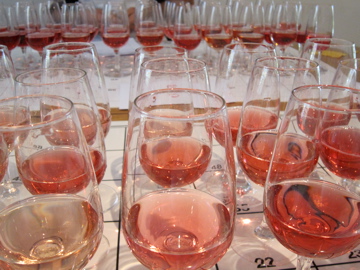By Sharon Wild
Written in Nice in August 2009 for National Liquor News
Rose coloured glasses are increasingly popular on the world stage. And while it’s a wine type truly diverse in terms of style, it’s generally not taken very seriously – by the industry and consumers alike. Indeed, rose as a category is commonly lumped together with reds – especially when it comes to industry statistics. With bourgeoning interest in the style, however, there’s some exciting innovations that are enchanting our palates and challenging negative perceptions towards roses.
‘The world doesn’t need another great red, so why not try and create the world’s best rosé – and prove that it can be taken seriously.’ stated Sacha Lichine; winemaking heavyweight in Bordeaux and son of the great vintner and writer Alexis Lichine, while explaining his latest challenge in Decanter Magazine. ‘To attempt to create another great Bordeaux or Burgundy would take 3 generations to do something dramatic. So I decided to look at regions where I could really make a difference on the fine wine stage – and sooner rather than later.” And that is precisely what he’s doing.
Welcome, everyone, to a new chapter in the world of Rosé.
Reflecting on Mr Lichine’s sentiments, it does seem bizarre that no one has really attempted to do this till now. After all, rosé sales internationally have been going through the roof lately. In the UK, they increased by an almighty 27% last year and doubled over the past four, while white and red wine sales remained stagnant. The category now represents around 5-7% of the world wine market. Australia, France, the US and Japan have also experienced growth, albeit not as dramatic as the UK. So we apparently love rosé.
The rosés that are tickling us all pink are produced all over the globe. Around 75% comes from Europe, while the USA produces circa 20% and Australia and New Zealand lag behind with a teensy 2%. The powerhouse of rosé production is Provence, France. Here, 80% of France’s rosé is made (around 11 million cases per annum) equating to 8% of the world’s total.
Provence occupies a huge chunk of southern France. It’s divided into three key Appellations; the Côtes-de-Provence is in the east and spreads over 20,000 hectares from Aix-en-Provence as far as Fréjus (which is not far from the glitz and glamour of St Tropez). Aix-en-Provence is in the western part of Provence and stretches from the Rhône Valley in the west to Montagne Sainte-Victoire in the East. The Côteaux Varois en Provence is sandwiched between the other two areas, in the stunning Var which lies to the north of the industrial port town; Toulon.
Production isn’t just about quantity. It’s worth noting that 75% of Provence Rosé is AOC classified. Jancis Robinson stated in her column in June 2009; ‘the more rosés I taste, the more I am convinced that the corner of the world that makes the best rosé is the most obvious place of all; Provence.’ Indeed, Provence was Sacha Lichine’s chosen home from which to embark upon his rosé challenge. His property; Château D’Esclans, is located in the very heart of the region in 2006, in the pretty village of La Motte.
The varieties used to make rosé in the various appellations of Provence are a happy marriage between the east and west regions that surround it. The region’s proximity to the Rhone in the east accounts for the grenache, cinsault, shiraz, mourvedre and rolle. Bordeaux to the west is reflected in cabernet sauvignon. Domaine Ott, for example, uses cabernet sauvignon, grenache and cinsault to produce their Château de Selle Rosé. Grenache from stately 80-year-old vines on the D’Esclans property form the backbone of his top cuvees.
While rosés are produced from a gamut of varieties in Australia, some of the best-known are also produced from old vine grenache and include Charlie Melton’s Rosé Virginia and Turkey Flat Rose.
Provençal, and indeed European rosé wines, are traditionally made from the brief maceration and soft pressing of red grapes. The result is not only a much lighter, clearer colour, but also a virtually tannin-free wine. Recently, proposed changes to rosé production in the EU, which would have allowed red and white wines to be blended to make rosé (outside Champagne), were abandoned. At the time, the European Commission insisted the changes would simply allow European winemakers to adopt the same techniques as New World rivals.
Asides what European wine laws stipulate, another fundamental difference between the new world rosés (Australia, New Zealand, USA etc) and those of Provence (and Europe generally) is the resulting style. Aussie rosés are generally bright in colour and in their fruit, bold in design and commonly off-dry especially at entry level (some from the USA are downright syrupy!).
Provencal rosés are generally paler, drier and more delicate, even at the cheerful quaffing end of the market. Chrissie McClatchie, Sales & Administration manager with Vin Sans Frontieres (suppliers of wines to Superyachts in the Côte D’Azur) and rosé lover bar none says; ‘the great thing about Provence Rosé is that they’re dry. I think there is so much potential in Australia to exploit this kind of style.’
Samantha Connew, Senior Winemaker of Wirra Wirra in McLaren Vale, observes of the Australian market for rosé; ‘Certainly since we have been producing a rosé (first vintage in 2002) there has been a huge increase in the number of rosés on the market and more general acceptance of the style. I think people are looking for a more savoury, or a drier style than they were some years ago.’
Sam’s comments are supported by the fact that one of the top selling rosés in Australia of recent times is the Arrogant Frog Shiraz Rosé. These wines hail from the Languedoc, France, are produced by French winemaker, Jean-Claude Mas and are distributed through national retailer Dan Murphy’s. When asked whether she thought there was room in Australia for imported rosé’s such as those from Provence, Sam Connew says; ‘it would be great to see more challenging styles from France thrown into the mix.’
The most challenging – and inspiring – rosés of Provence, which are not yet available in Australia, are undoubtedly those of D’Esclans. In his quest to make kick-arse rosé Sacha Lichine enlisted the help of Patrick Leon (esteemed winemaker of Château Mouton Rothschild and Opus One). The top of the D’Esclans range – and the contender for the world’s greatest rosé – is the extraordinary Garrus. Meticulously crafted from old-vine grenache, the grapes are individually processed to eliminate all traces of stalk. The wines is then fermented and matured in barriques that are individually temperature controlled. The result is a softness and fruit quality that defies belief.
And so does its price tag. At around EUR80 (Approximately AUD130), it is also currently the world’s most expensive rosé outside Champagne. But is it worth it? Well, after only two vintages, the Garrus is commanding attention well beyond the Côte D’Azur and sells out within a couple of weeks of release. Wine Spectator, for example, awarded the wine 90 points; “Very creamy and rich, with concentrated flavors of berry, cherry, pepper and spice. Broad and lush on the minerally finish.”
If you can’t find (or afford) the Garrus, the Whispering Angel is the introduction to the D’Esclans range. It’s delicately scented with herbaceous plants and flowers, is soft and dry on the palate and the flavour lingers like a fine Rosé Champagne (approximately EUR20 retail in France).
If you do happen to be in Provence, other rosé’s definitely worth seeking out include Château Margüi. Philippe Guillanton was the number three employee of Yahoo France and, in favour of a sea change for him and his young family, was seduced by the Margüi property in the Côte Varois with its stately stone mansion, spectacular views of the area, not to mentioned its run down vineyards. Philippe and his wife Marie-Christine reinvigorated the vines using biodynamic techniques and turned their hands to winemaking. Their resulting rosé is made from cinsault and grenache, is lightly coloured, with vibrant, dancing red fruit flavours, a soft structure and a long, succulent finish.
Philippe isn’t alone in being seduced by a property in the area; his new neighbours are none other than Brad and Angi – who bought Château Miraval. Acclaimed as one of the top 500 vineyards in France by Guide Hachette, Château Miraval is simply a magical place. Their rosé is named Pink Floyd because the band recorded ‘The Wall’ at the property’s recording studio; possibly after a few glasses of their delicious, crisp yet fruity rosé!
Château Simone Palette Rosé is rated as one of the ‘1001 Wines You Must Try Before You Die’. This Côtes de Provence represents virtually on its own the Appellation of Palette. Made from a huge variety of local grape varieties, it is a powerful, deeply coloured, intense rosé.
The best-known winery in the Provence region is undoubtedly Domaine Ott. It has a bustling cellar door at its Mireille property, where it provides vinous relief to road-raged beach goers tackling the ever-gridlocked ocean road to St Tropez.
If you are planning to tour the wineries of Provence, however, you won’t find anywhere to eat lunch after 2pm; you’ll only end up hungry and possibly more road-raged. But not thirsty, at least. It’s an exciting new era in the world of rosé wines. Anticipate more new chapters.
A very handy website for further information about the region is vinsdeprovence.fr


